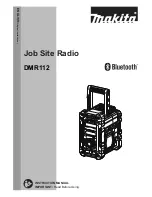
CDX800 DESCRIPTION
I/O signals wiring diagram
3.2.4.
I/O signal parameters
Signal
name
Measuring
range [V]
Resolution
[bit]
Sampling
[ms]
Average from
samples
Hysteresis Control level
I/O1-5
0 to 5
10
100
Optional
1 - 128
Optional
0 - 255
Optional
3.3. Measuring other CDX 800 signals
3.3.1.
Measuring the supply voltage
In CDX 800, two more signals are evaluated. The first is called UN+ (DC SUPLY); it is
an internal signal and measures supply voltage on CDX 800 supply terminals. The measuring
ranges from 0 to 30 V. The supply voltage value influences the function of CDX 800.
The second one is INAC (AC SUPLY) linked to the supply connector (see the supply
connector description). The measuring ranges from 0 to 30 V. The signal is protected against
over-voltage by a protection element that blocks voltage in excess of 16 V. INAC is designed
for measuring of network supply voltage presence. Change of the value is recorded in CDX
800 statistics as a failure and rise of supply voltage 230 V.
Beware - it is impossible to connect 230V supply voltage directly to the input!
Signal
name
Measuring
range [V]
Resoluti
on [bit]
Sampling
[msec]
Average from
samples
Hysteresis Control level
UN+
0 to 30
10
5000
4
2V
Optional
INAC
0 to 30
10
5000
4
2V
Optional
3.3.2.
Measuring internal CDX 800 temperature
Signal
name
Measuring
range [°C]
Resolutio
n [bit]
Sampling
[msec]
Average from
samples
Hysteresis Control level
TEP
-40 to 100
10
5000
16
2
o
C
Optional
3.3.3.
Measuring DSR output signal level
DSR signals on separate user interfaces are output signals from CDX 800 viewpoint.
They are not controlled from the inside. Individual signals are linked through 330 Ohm
resistors.
By placing a 100 Ohm ground resistor on the DSR output, the voltage will fall to 1 V.
Following this fall, CDX 800 will recognize service cable connected and start to communicate
on this user interface via the ARNEP protocol with defined communication parameters. It is not
allowed to load the output to a level when voltage falls below 3 V.
37








































